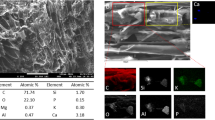Abstract
Two different types of adsorption gels were prepared from biomass wastes. The first gel was produced from astringent persimmon peel rich in persimmon tannin, a polyphenol compound, which was prepared by means of simple dehydration condensation reaction using concentrated sulfuric acid for crosslinking. This adsorption gel was intended to be employed for the removal of radioactive elements, uranium (U(VI)) and thorium (Th(IV)), from rare earths. The second gel was prepared from chitosan, a basic polysaccharide, produced from shells of crustaceans such as crabs, shrimps, prawns, and other biomass wastes generated in marine product industry, by immobilizing functional groups of complexanes such as ethylendiaminetetraacetic acid and diethylentriaminepentaacetic acid (DTPA). This gel was developed for the mutual separation of rare earths. Of the two adsorption gels evaluated, the DTPA immobilized chitosan exhibited the most effective mutual separation among light rare earths.












Similar content being viewed by others
References
T. Matsuo and S. Ito, Agric. Biol. Chem. 42, 1637 (1978).
T. Sakaguchi and A. Nakajima, Sep. Sci. Technol. 22, 1609 (1987).
K. Inoue, H. Kawakita, K. Ohto, T. Oshima, and H. Murakami, J. Radioanal. Nucl. Chem. 267, 435 (2006).
K. Inoue, K. Yoshizuka, and K. Ohto, Anal. Chim. Acta 388, 209 (1999).
T. Sakaguchi and A. Nakajima, Sep. Sci. Technol. 29, 205 (1994).
K. Inoue, K. Ohto, K. Yoshizuka, R. Shinbaru, and K. Kina, Bunseki Kagaku 44, 283 (1995).
K. Inoue, Advances in Chitin Science, Vol. 4, ed. M.G. Peter, A. Domard, and R.A.A. Muzzarelli (Potsdam: Universitaet Potsdam, 2000), pp. 460–465.
F.H. Spedding and A.H. Daane, The Rare Earths (New York: Wiley, 1961), p. 55.
K. Takeda, M. Akiyama, F. Kawakami, and M. Sasaki, Bull. Chem. Soc. Jpn. 59, 2225 (1986).
M. Kanesato, T. Yokoyama, and T.M. Suzuki, Bull. Chem. Soc. Jpn. 62, 3451 (1989).
T. Yokoyama, S. Asami, M. Kanesato, and T.M. Suzuki, Chem. Lett. 383 (1993).
Author information
Authors and Affiliations
Corresponding author
Rights and permissions
About this article
Cite this article
Inoue, K., Alam, S. Refining and Mutual Separation of Rare Earths Using Biomass Wastes. JOM 65, 1341–1347 (2013). https://doi.org/10.1007/s11837-013-0716-y
Received:
Accepted:
Published:
Issue Date:
DOI: https://doi.org/10.1007/s11837-013-0716-y




